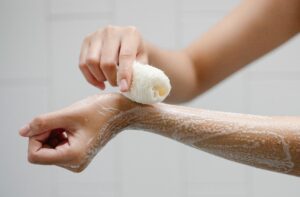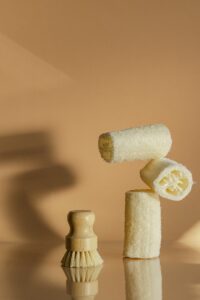Fresh and Clean

When it comes to personal hygiene, we often focus on our bodies and forget about the tools we use to keep ourselves clean. Bath sponges and loofahs are popular choices for many people, but they can quickly become breeding grounds for bacteria and mold if not properly cared for. In this blog, we’ll discuss how to properly care for your bath sponge or loofah to keep it clean and long-lasting.
1. Rinse Thoroughly After Each Use
The first step in caring for your bath sponge or loofah is to rinse it thoroughly after each use. Use warm water to remove any soap or body wash from the surface of the sponge or loofah. Make sure to squeeze out any excess water, as lingering moisture can encourage the growth of bacteria.
2. Hang to Dry in a Well-Ventilated Area
After rinsing, hang your bath sponge or loofah to dry in a well-ventilated area. Avoid leaving it in the shower or bathtub, as the moisture and humidity can promote the growth of mold and mildew. Instead, hang it in a location with good air circulation, such as a towel rack or shower caddy.
3. Replace Regularly
Even with proper care, bath sponges and loofahs will eventually wear out and need to be replaced. As a general rule, you should replace your bath sponge or loofah every four to six weeks. If you notice any signs of wear and tear, such as frayed edges or a foul odor, it’s time to replace it sooner.
4. Cleanse With Vinegar or Bleach
If you want to give your bath sponge or loofah a deeper clean, you can use vinegar or bleach. For vinegar, mix equal parts water and white vinegar in a bowl and soak the sponge or loofah for 15 minutes. Rinse thoroughly with warm water and hang to dry. For bleach, dilute one tablespoon of bleach in one gallon of water and soak the sponge or loofah for five minutes. Rinse thoroughly with warm water and hang to dry.
5. Don’t Share With Others
While it may be tempting to share your bath sponge or loofah with others, it’s not a good idea. Sharing these items can transfer bacteria and other germs from one person to another, increasing the risk of infection or illness. It’s best to use your own bath sponge or loofah and avoid sharing with others.
6. Avoid Using on Sensitive Areas
Bath sponges and loofahs can be abrasive, so it’s important to avoid using them on sensitive areas of the body, such as the face or genitals. Instead, use a gentle cleanser and your hands to clean these areas.

7. Choose Natural Materials
When shopping for a new bath sponge or loofah, consider choosing natural materials, such as sea sponges or natural loofahs. These materials are biodegradable and less likely to harbor bacteria than synthetic materials.
In conclusion, taking care of your bath sponge or loofah is essential for maintaining good personal hygiene. By following these tips, you can keep your bath sponge or loofah clean and long-lasting. Remember to rinse thoroughly after each use, hang to dry in a well-ventilated area, replace regularly, cleanse with vinegar or bleach as needed, avoid sharing with others, avoid using on sensitive areas, and choose natural materials when possible. With these simple steps, you can enjoy a clean and refreshing shower or bath every time.

